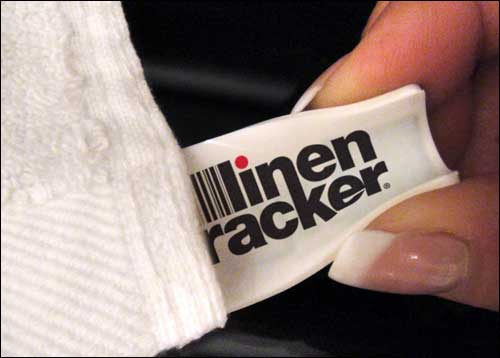A number of hotels employ radio frequency identification technology to track uniforms, provide keyless entry or simplify registration (see Hotel Keeps Uniform Inventory With RFID and At Nelson Lodge, RFID Will Unlock More than Doors). Now, a startup called Linentracker is offering an RFID system that a site can use to take inventory of its towels and sheets, while also making the process of laundering and replenishing those items more efficient.
The company initiated its first pilot project with a California hotel early this year. The project was initially scheduled to run for six months, says William Serbin, Linentracker’s executive VP, but it was extended indefinitely based on the positive results the technology provided the hotel.
Linentracker’s solution is based on passive ultrahigh-frequency (UHF) tags and interrogators compliant with the EPC Gen 2 (ISO 18000-6c) standard. The system is designed to enable a hotel to access real-time inventory levels of its linen stock throughout its property, as well as optimize its linen laundering and ordering processes.
At the pilot project site, which Serbin declines to name, an Alien Technology RFID reader is mounted inside a linen closet on each of the 10 floors of guest rooms. Interrogators are also installed at various points throughout the hotel’s laundry room. An RFID tag is attached to each of the facility’s 20,000 pieces of linen, from towels to sheets and pillowcases. The tags, also provided by Alien Technology, are sealed within a waterproof flexible material designed to protect the inlay from the extreme temperatures and shock to which the linens are exposed during laundering. A tag is sewn into the seam of each piece of linen.
According to Serbin, most hotels count linen inventory manually, so employing the RFID system would greatly reduce labor costs, while also improving accuracy.
As housekeepers clean rooms during the day, Serbin says, they typically place soiled linens in a chute leading to the laundry facility. The soiled items are cleaned throughout the day. At night, a staff member checks each closet’s inventory, then stocks the linen cart assigned to that floor with all of the towels and sheets the housekeeper will need to restore that closet’s inventory level.With the Linentracker system, however, laundry employees can monitor each linen closet’s inventory remotely, by checking stock levels displayed on a computer in the laundry area. Each tag is encoded with a unique ID number that identifies the type of linen. The reader mounted within each closet collects the tag ID numbers, and RFID middleware provided by KeyTone Technologies, a Santa Clara, Calif., provider of enterprise solutions, filters out redundant reads and sends the clean data to a software application that Linentracker developed in house. This software allows the hotel staff to view the inventory levels for each type of linen inside the closets in real time.
Combining the inventory numbers and tracking the soiled linens as they enter the laundry area, the Linentracker software also generates instructions for laundry workers regarding how much of the soiled linens they will need to launder in order to fulfill expected demand for the following day. This means the laundry staff can optimize their wash cycles and avoid running unnecessary, less-than-full loads, thereby reducing energy and water usage.
Using the real-time inventory data for the linen closets, the staff can stock the housekeeping carts for the next day without having to manually check each linen closet. Serbin says the hotel running the pilot project has identified this as one of the greatest benefits the Linentracker system offers—not only because it saves times, but also because it ensures inventory accuracy. “The biggest thing they are excited about,” he says, “is seeing inventory—having the right numbers on floors so the closets are properly stocked when housekeepers get to work.”
According to Serbin, the RFID tags can withstand at least 150 wash-and-dry cycles. This exceeds the industry average of 100 laundering cycles before a piece of hotel linen is discarded (due to staining or being threadbare) or lost, he says.
The Linentracker software maintains lifecycle data on each item, tracking the number of wash-and-dry cycles through which it is put until the point at which the staff determines it should be discarded. Consequently, hotels will be able to ascertain which linen suppliers provide the highest quality, longest-lasting products. On the flipside, they will also be able to identify poor stock that does not last as long as expected.
“Our mission is to assist hotels in tracking their moveable assets efficiently, in order to enhance the guest experience,” Serbin states. “The existing process [for maintaining laundry] is manual and time-consuming. We are unlocking the mysteries by knowing where the items are at all times.”
Another potential Linentracker application is deterring employee theft. At the pilot site, an RFID reader is mounted at the employee exit and entrance point. This way, the system can detect whether workers are bringing tagged linens into or out of the facility. Serbin declines to comment on whether the system had actually spotted any theft at the pilot site.


